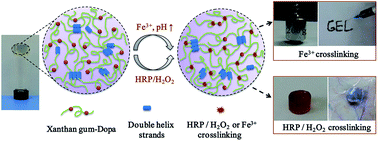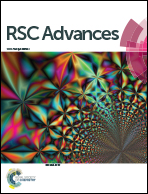Injectable shear-thinning xanthan gum hydrogel reinforced by mussel-inspired secondary crosslinking
Abstract
Shear-thinning hydrogels fabricated by dynamic and weak interactions usually possess low mechanical strength, high swelling behavior and rapid corrosion/dissociation rate. A xanthan gum (XG) aqueous solution presented weak gel and shear-thinning properties due to XG double helical strand structure. In this study, we introduced a secondary chemical crosslinking network in the XG double helical strand network. Dopamine (Dopa) was conjugated to XG via an amidation reaction. The conjugated Dopa groups were oxidized by horseradish peroxidase (HRP) and H2O2 to form a crosslinked covalent network, or coordinated/oxidized by Fe3+ ions to form a crosslinked coordination/covalent network. At the early stage of the secondary crosslinking, the hydrogels displayed excellent thixotropic property. After the formation of the secondary network, the thixotropic property disappeared, but the mechanical strength, swelling ratio and degradation rate of the hydrogels were greatly improved. Both in vitro and in vivo investigations revealed that the XG–Dopa/HRP/H2O2 hydrogel was an injectable, biocompatible and biodegradable hydrogel material. This study demonstrated that forming a Dopa-mediated covalent crosslinking network in a shear-thinning hydrogel network is a facile and effective strategy for maintaining the injectable shear-thinning property as well as improving the stability and mechanical strength of the hydrogel.


 Please wait while we load your content...
Please wait while we load your content...